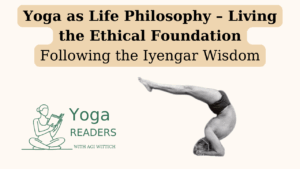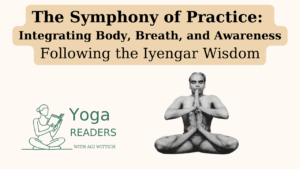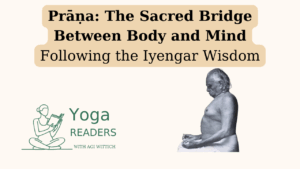
Yoga as Life Philosophy – Living the Ethical Foundation
“Yoga is the rule book for playing the game of Life, but in this game no one needs to lose.” This profound statement from

In the vast tradition of yoga āsanas, certain poses carry not just physical significance but deep historical and spiritual resonance. Bharadvājāsana, named after the revered sage Bharadvāja, is one such posture that connects us to ancient wisdom while offering profound benefits for modern practitioners.
Bharadvāja stands as one of the most influential sages of ancient India. As one of the Saptarishis (Seven Great Sages), his contributions span multiple domains of knowledge – from Vedic literature and Ayurveda to Sanskrit grammar and military science. As Geeta Iyengar notes in “Yoga: A Gem for Women,” Bharadvāja was “the father of Dronacharya, who was the Guru of the Kauravas and the Pandavas,” linking him directly to the sacred narrative of the Mahābhārata.
To explore another powerful posture rooted in myth, read about Vīrabhadrāsana and its sacred origin story, connecting practice to the warrior spirit of Vīrabhadra.
The Quest for Infinite Knowledge
One of the most profound stories about Bharadvāja comes from the Purāṇas, illustrating his dedication to learning and the ultimate purpose of spiritual study. According to this narrative, Bharadvāja had an intense desire to master all Vedic knowledge, but he was aware that human life is limited. To achieve his goal, he performed severe penances to please Lord Indra.
Pleased with Bharadvāja’s devotion, Indra appeared before him. The sage requested, “Please give me a hundred more years so that I can complete studying the three Vedas.” Indra granted his wish, saying, “Tathāstu” (let it be so). This cycle continued five times, with Bharadvāja extending his life each time to continue his studies.
When Bharadvāja prayed to Indra for longevity once again, Indra decided to teach him an important lesson. He took three handfuls of dust and said, “Even if you live for countless years, you have studied only this much of the infinite Vedas,” showing him the three small handfuls compared to the entire earth.
Shocked, Bharadvāja realized that despite extending his lifespan five times, he had only scratched the surface of Vedic knowledge. Indra replied, “The Vedas are unlimited. Only Lord Viṣṇu can know them completely. The best thing is to realize the purpose of the Vedas. The goal of all the Vedas is Lord Hari. Meditate on Him and fulfill the goal of all the Vedas.”
Following Indra’s advice, Bharadvāja went to Mattapalli and meditated on Lord Narasiṃha. Pleased with his penance, Lord Narasiṃha appeared before Bharadvāja and bestowed upon him a residence in Vaikuṇṭha.
The Sacred Meeting in the Rāmāyaṇa
Another significant story involving Bharadvāja appears in Vālmīki’s Rāmāyaṇa. During Rāma’s fourteen-year exile, Rāma, Sītā, and Lakṣmaṇa reached the confluence of the Gaṅgā and Yamunā rivers at Prayāg. There, guided by the rising smoke of his sacrificial fire, they found Bharadvāja’s hermitage.
As the Rāmāyaṇa describes: “Charmed with the prospect ever new / The glorious heroes wandered through… / And now the day was half-way sped / When thus to Lakshman Rāma said: / ‘There, there, dear brother, turn thine eyes; / See near Prayāg that smoke arise: / The banner of our Lord of Flames / The dwelling of some saint proclaims.'”
Bharadvāja welcomed them warmly and asked them to stay at his hermitage for the entire duration of their exile. However, Rāma insisted on going deeper into the forest to Citrakūṭa, which was three krośa (about nine miles) away from the hermitage. Bharadvāja then gave them directions and blessed their journey.
This meeting demonstrates Bharadvāja’s role as a guide and protector, offering sanctuary to those following the path of dharma, while respecting their chosen journey.
The Birth of Droṇācārya
According to the Viṣṇu Purāṇa and the Mahābhārata, Bharadvāja had a brief encounter with the apsarā (celestial nymph) Ghṛtācī. According to one version in the Mahābhārata, Droṇa was born when “Bharadvāja ejaculated his semen in a pot” upon seeing the apsarā. This unusual birth story links Bharadvāja directly to two important characters of the Mahābhārata – Droṇācārya and Aśvatthāmā, the son of Droṇa.
Bharadvāja then trained Droṇa in the use of weapons and the sacred science of Dhanur-veda (archery), as mentioned in chapter 12.203 of the Mahābhārata.
The pose named after this great sage is a seated twist that embodies both precision and therapeutic potential. As Geeta Iyengar describes in detail, “This asana works on the dorsal and the lumbar regions of the spine, removing stiffness and pain. It is a good pose for slipped discs.”
Geeta Iyengar emphasizes that twisting āsanas like Bharadvājāsana are particularly important for women: “The asanas in this section rotate and twist the spinal column and the trunk laterally. They are extremely beneficial to women and should be practised daily. They tone, massage, and rejuvenate the abdominal organs.”
The technique, as outlined by Geeta Iyengar, requires careful attention to several key elements:
“Revolve the trunk in such a way that the right side of the body comes almost in line with the left thigh,” she instructs, emphasizing the importance of proper alignment. She further notes that practitioners should “tuck the shoulderblades in and lift the sternum up,” while keeping “the spine erect and turn it on its axis.” For deeper guidance on how Geeta and B.K.S. Iyengar each taught such postures, watch my lecture: Two Voices, One Path: Exploring Asana through Guruji and Geetaji.
For those who find the full expression challenging, Geeta Iyengar provides compassionate modifications: “If the left arm does not reach the right upper arm behind the back, swing from the left shoulder and move the left arm more so that it reaches the right arm. However, the swing should be mild and not violent.”
The therapeutic benefits of Bharadvājāsana reflect the holistic understanding of the body that characterized Bharadvāja’s own contributions to Ayurveda. The twist works deeply on the spine while massaging and stimulating internal organs – a perfect example of how āsana practice can support both structural and physiological health.
Modern Applications
For contemporary practitioners, Bharadvājāsana offers particular relevance. As Geeta Iyengar explains, this pose can be modified for different bodies and conditions. She provides specific instructions for practitioners who might experience difficulties: “Often one experiences a cramp in the buttocks in the right buttock when one is rotating to the left and vice versa. Place a blanket 2 to 2½ inches thick under the buttocks, keeping the feet on the floor. This will help turn the sides of the pelvis more.”
She also offers wall variations for beginners: “In the beginning this asana may be practised near a wall so that the hips can twist more easily.” This demonstrates her understanding that accessibility is key to building a sustainable practice.
The beauty of Bharadvājāsana lies in its accessibility and adaptability. Whether practiced against a wall for support or in its classical form, the pose offers benefits for practitioners of all levels. As Geeta Iyengar emphasizes, proper technique and awareness are crucial: “Do not change the position of the knee while turning, as it tends to move to the left… see that the body does not lean backwards. Keep the left hip and the left shoulder in line.”
The Broader Benefits of Twisting Practice
Geeta Iyengar explains the comprehensive effects of twisting āsanas like Bharadvājāsana: “These asanas are extremely helpful in relieving rheumatism, backache, and pain in the spinal column… They are a boon for those who suffer from indigestion, acidity, appendicitis, irritation of the intestines, diabetes and flatulence. They are useful for alleviating disorders of the kidneys, the liver, the spleen, and the gall-bladder.”
She continues, highlighting their particular relevance for women: “Menstrual disorders, malfunctioning of the endocrine glands, and obesity are all remedied greatly by the practice of these asanas. They relieve back pain and exhaustion due to overwork or during the menstrual period.” I explore these themes further in my lecture, Aligning with Change: Iyengar Yoga’s Adaptations for Women’s Life Cycles.
Just as Bharadvāja was known for his dedication to knowledge and spiritual growth, the practice of Bharadvājāsana invites us into a space of inner awareness and transformation. The twist literally helps us look back – both physically and metaphorically – perhaps encouraging the kind of self-reflection and wisdom-seeking that characterized the sage himself.
A Bridge Between Ancient and Modern
Bharadvājāsana serves as a beautiful bridge between ancient wisdom and modern practice. Just as Bharadvāja was known for his vast knowledge across multiple disciplines, this pose offers multiple layers of benefit – physical, therapeutic, and spiritual.
For contemporary practitioners, the pose reminds us that yoga is not just about physical movement but about connecting to a deeper tradition of wisdom and understanding. When we practice Bharadvājāsana, we’re not just performing a twist – we’re participating in a lineage of knowledge that stretches back to one of India’s greatest sages.
Through mindful practice of this pose, we can honor both the sage’s legacy and our own journey toward greater understanding and well-being. As we twist and turn, we might remember Bharadvāja’s dedication to knowledge and healing, allowing these qualities to inform our own practice and understanding of yoga’s transformative potential.
Whether you’re approaching this pose for its therapeutic benefits, its role in a general yoga practice, or its connection to yoga’s rich heritage, Bharadvājāsana offers a profound opportunity for exploration and growth. In this way, it truly embodies the multifaceted wisdom of its namesake sage. To explore one of yoga’s foundational philosophical systems, watch my recorded lecture on Sāṃkhya Philosophy and Yoga Practice.
If this article inspired you and you’d like to support more writing like this, you can Buy Me a Chai and help nourish this work.
Reflective Questions
As you explore Bharadvājāsana in your practice, consider these questions for deeper contemplation:
The practice of Bharadvājāsana invites us to embody the qualities of its namesake sage – wisdom, healing knowledge, and dedication to growth. Through mindful engagement with this pose, we honor both ancient tradition and our own evolving understanding of yoga’s transformative power.

“Yoga is the rule book for playing the game of Life, but in this game no one needs to lose.” This profound statement from

“The rhythm of the body, the melody of the mind, and the harmony of the soul create the symphony of life.” With these poetic

“Prāṇa is the vehicle of consciousness.” — B.K.S. Iyengar, Light on Life This concise yet expansive statement from B.K.S. Iyengar reveals a foundational truth:
Agi Wittich is a yoga practitioner since two decades, and is a certified Iyengar Yoga teacher. Wittich studied Sanskrit and Tamil at the Hebrew University of Jerusalem, Israel, completing a PhD with a focus on Hinduism, Yoga, and Gender. She has published academic papers exploring topics such as Iyengar yoga and women, the effects of Western media on the image of yoga, and an analysis of the Thirumanthiram yoga text.